|
Women's Participation in the Workforce
- Challenges and Characteristics in
Jordan

Zeena Moutaz Khalaf
Leen Adel Nakhaleh
Mervat Waleed Abu Sara
Department of Business Administration,
King Talal Faculty of Business and
Technology,
Princess Sumaya University for Technology,
Amman, Jordan

Abstract
Women are considered half of any given
society, and accordingly, empowering
women is considered a tool of development,
especially in our Jordanian economy.
This research aims to investigate
the reasons behind women leaving the
workforce and not contributing back.
We chose to conduct an IE framework
to analyze the factors that affect
female employees within and out of
their working environment. Jordan
is one of the many countries that
value its traditions and cultures.
This has an influence on how people
think and perceive the role of women
in our society, and in some cases
ascribes women to a specific role,
such as in the household. As a result,
female employees in our society consider
their job secondary to their traditional
role as a mother. Accordingly, any
practices that may harm their level
of effectiveness within their home
may lead them to drop out from the
workforce and not contribute back
in order to fulfill their maternal
role.

Introduction
In the last 50 years, women have been
raised and taught to be mothers for
their children, professional cooks
for their families and super housekeepers
who keep their home neat and clean.
Our society has excluded women from
being productive individuals and has
restricted women's ambitions, by not
giving them the chance to leave aside
the burden of family and traditions.
For some women, this does not stop
them. Many leading, ambitious and
hard-working women have fought for
their dreams and have tried to initiate
a remarkable revolution in society
to encourage and engage other women
to participate in the workforce. But
unfortunately the participation of
women is still considered very low
and being a working woman is uncommon.
Unfortunately, despite the high level
of women's education and open vacancies
for women to take in the workforce,
the levels of their participation
are still not high enough (Al-Badayneh,
2012).
Nowadays, the economic growth of any
country needs the dedication and hard
work of all their individuals. The
high percentage of non-working women
has been highlighted as a direct threat
to the economy as it is considered
an extra cost which causes lower levels
of proficiency and productivity, especially
in Jordan and the Middle East (Kharouf
& Weir, 2008).
Women are recognized as having the
potential in society to increase economic
growth; many studies have shown that
despite the low participation of women
in the workforce, a distinctive improvement
in health and education conditions
has occurred over the past several
decades (Peebles, Darwazeh, Ghosheh
& Sabbagh, 2007).
In return, organizations and business
owners have neglected business ethics,
and gender discrimination is prevalent.
Organizations have acknowledged that
women's rights pose higher costs and
classified women as non-productive
employees.
Literature review
Female participation in the workforce
is determined by the percentage of
females engaged in the total working
population of a state or country (Pegu,
2015).
Accordingly, women's rights (Doepke
& Tertilt, 2011), parliamentary
representation (Stockemer & Byrne,
2011), women entrepreneurship (Hattab,
2012), and women empowerment are concepts
that have been spread widely through
the press, as well as in studies and
activisms. In addition, the different
types of discrimination that women
face in and out the working environment
(e.g. the income gap, gender inequality,
political factors, and social factors)
have been investigated.
The national development of human
rights (2004) noted that" Women's
low participation rates in the economy
and in the private sector present
a high cost to the Jordanian economy."
According to this statement, Jordan
is a country that needs to encourage
women to participate more in the workforce.
As such, the reasons behind women's
low participation in the workforce
need to be acknowledged, and alternative
solutions should be taken into consideration,
to ensure growth in the Jordanian
economy. Especially, it should be
acknowledged that many women in Jordan,
particularly the younger generation,
are very well educated as they are
considered a waste of human resources
in Jordan.
There are two types of factors that
influence women employees:
a. Internal organizational
factors
b. External organizational
factors
Internal Organizational Factors
Internal organizational factors are
conditions, entities, events and factors
within an organization that influence
its activities and choices, and the
behavior of the employees.
Women face many challenges in their
daily life, especially in the workplace.
Discrimination toward women has been
propagated in organizations. Unequal
opportunities occur based on gender
bias and inequality along with gender
stereotypes. However, this reduces
the effectiveness of organizational
operations and weakens the bond that
should be built between employees,
affecting their motivation, and diminishing
their productivity (Equality &
Education, 2012).
Internal organizational factors affect
female employees within the organization
structure (Mogyoro, 2011), and may
cause instability in the organization
environment. Furthermore, they may
affect the level of female participation
and the effectiveness of the organization's
activities.
These factors are categorized as:
gender stereotypes, income gap, unequal
opportunities and gender inequality,
but they are all related and affect
each other, causing discrimination
toward women within the workplace
environment.
Gender Stereotype
The stereotypes that are connected
with gender perceptions identify the
personality, behavior, roles, skills
and physical appearance that are to
be expected from men and women (Crowley,
2013).
Women today are perceived as less
capable of handling job difficulties,
especially if they have other priorities
like a family. Many obstacles arise
based on their stereotypical role
that hinder their personal and professional
role, as reflected in the fact that
women are underrepresented in high
levels of management (Aycan, 2004).
Researchers have discussed how negative
stereotype ideas are based on women.
It has been noted that gender roles
commonly lead to the discouragement
of women's employment outside the
home in non-traditional jobs (Heilman,
1997; Schreiber, 1998).
Therefore, these trends and perceptions
toward women have left them doubting
their own abilities. They are less
confident and uncertain of their expertise
(Al-Badayneh, 2012), which will contribute
to the discouragement of women in
participating in the workforce.
As a study has noted, existing sex
roles exert real pressures on individuals
to behave in a certain prescribed
way (Broverman, 1972). Accordingly,
the stereotypical role of a woman's
job is perceived as a feminine type
of job that matches the traditional
role as a caregiver, like teaching,
nursing, childcare, and secretarial
work. Plus, the stereotypical role
for men is one that is masculine,
which needs to match their traditional
role as a breadwinner like engineering,
sales, and insurance agent. This mismatch
between stereotypical roles and desirable
work roles has a negative effect on
workplace evaluation for the employee
positioning and promoting process
(Heilman & Eagly, 2008).
Gender inequality
After investigating gender inequality
further, researchers have found that
gender inequality does have a negative
impact on female participation in
the workforce (Peebles et al., 2007).
It may lead them to drop out from
the workforce to stop being neglected.
Studies have shown that women get
paid less than men (Peebles et al.,
2007), based on gender discrimination.
Another example of real gender inequality
can be found in banks, where some
banks prefer to employ males rather
than female employees, as they consider
them to be a burden. From the organization
point of view, females may take maternity
leave and may represent a cost for
the company.
Some male employees do not accept
to be controlled by their female manager,
as the male ego will always interfere
in accepting females as bosses. The
traditional way of thinking and their
traditional role in our society will
cause them to behave in a certain
way (Saunders, 2013).
Unequal opportunities
Traditions have greatly affected the
way people think in our society. With
time, more opportunities have appeared
and there have been major changes
for women and their role in the society.
Despite this fact, discrimination
still exists based on traditional
views of women, which limits the advancement
of women in their career. In some
cases, it pressures them to drop out,
as a result of frustration and disappointment,
due to gender bias leading to unequal
opportunities in the workplace (Tlaiss
& Kauser, 2011).
Organizations are highly affected
by cultural values and stereotypical
viewpoints, which are, in turn, highly
affecting the way organizations operate.
Therefore, in some cases, this may
lead to discrimination toward female
employment (Metle, 2002; Khattab,
1996; Kausar, 1995).
The stereotypical and traditional
role of women is affecting their career
advancement, as men are perceived
more suitable for high level positions
than women. The attitude of "think
man/think manager" is taking
place in our society as the male character
is perceived to be more appropriate
for the management position (Jamali
et al., 2005).
Many studies have proven that training
and advancement in many cases is prioritized
for men rather than women. This gives
men the opportunity to acquire special
skills needed for the job requirements,
and increase their possibility to
grow within the organizational structure,
while keeping women in lower levels
of management (Weir, 2003).
Furthermore, there are unequal opportunities
based on gender-biased attitudes in
the employment process. Traditional
views observe women as quitters due
to marriage and child birth plans,
and females face harassment in the
interview stage by being asked personal
questions that are not usually asked
to men.
Income gap
Female participation in the workforce
is highly affected by the income gap.
Women tend to receive fewer earnings
than men, and stay in the same income
brackets for a longer period of time.
Many researchers considered this fact
to reflect the stereotypical role
of women in the society as a caregiver.
Consequently, they are perceived as
needing less raises and promotions
in comparison to men. In contrast,
men are perceived as breadwinners,
which are responsible for their household
expenses, including their wife and
kids. Therefore, this will lead to
unequal opportunities for women to
grow, and slower progression in their
careers (Tlaiss & Kauser, 2010).
But some studies have proven that
the income gap is highly related to
specific skills required, and the
level of education attained by women
(Moghadam, 2013). Others note that
it is more a result of gender discrimination.
There have been critics who have explored
that women are the reason behind the
income gap, because women tend to
make different choices about work,
marriage, and child birth. These factors
need to be taken into consideration
in determining the income gap between
men and women. But unfortunately,
this is considered to be a judgment
based on stereotypical attitudes towards
women, and mostly reflects an attitude
of gender discrimination that lacks
an understanding of a woman's situation
and needs (U.S. Dept of Labor, 2009).
The studies on the income gap between
women and men revealed that women
make 77% of what men make. This number
came from the comparison between men
and women with a full time job, and
it does not take into account the
type of job and working hours. For
example, the comparison was not made
between different teachers or between
different doctors. The US Department
of Labor took into account the education
and career choices as part of the
equation. By consideration of these
factors, they found that women make
nearly the same amount as men, which
is 94% (U.S. Dept of Labor, 2009).
Moreover, the choices those women
make about education affect how much
they earn, as women tend to go for
fields like health, education, and
social science, while men tend to
go for engineering and computer science.
Also, women tend to make different
choices about their jobs, as they
prefer to work part time jobs rather
than full time, due to family responsibilities,
and take maternity leave for childbirth.
As a result, the income gap between
men and women is not based on gender
discrimination; it is actually affected
by the choices that women and men
make.
External Organizational Factors
External organizational factors include
conditions, entities, events and factors
surrounding an organization that influence
its activities and choices, and determine
its opportunities and risks.
To determine the external organizational
factors, we are going to conduct the
PEST analysis, which is defined as
the external influences that affect
the business' environmental decisions
and performance, and can be classified
into political, economic, social,
and technological factors (Grant &
Jordan, 2012).
Political factors
Jordan has always been known for its
concern for human rights, and that
concern has been reflected on the
Kingdom's stability for the past 40
years. The Jordanian National Charter
has clear regulations related to human
rights.
Jordan has protected women in their
first National Charter regulation,
which is, "All Jordanians are
equal by the law and have the right
to assume public office and the right
to work."
In 1955, the government had given
only educated women the right to vote.
Then in 1974, all women were given
the right to vote, and the right to
participate in the general elections
("Jordan - Human Resources -
Human Rights," n.d.).
In contrast, in 1928, the United Kingdom
government gave all women the right
to vote on par with men (Ford, Goodwin
& Cutts, 2012). In addition, in
1920, the United States of America
gave all their citizens the right
to vote regardless of their sex (Keyssar,
2009).
In 1996, a national committee was
developed to support women among governmental
and non-governmental sectors. They
formulated general policies that defined
priorities and programs such as the
"Jordanian women union"
to support women in different fields
("Jordan - Human Resources -
Human Rights," n.d.).
Jordanian regulations and laws can
impact women's participation in the
workforce both positively and negatively.
Some of these regulations that intend
to protect women have also affected
their economical participation and
also caused discrimination against
them (Council, 2008).
The table below presents labor laws
and regulations, listed and discussed,
according to their effect on female
participation in the workforce (Peebles
et al., 2007).
Table 1: Laws and regulations that
impact women within the workforce
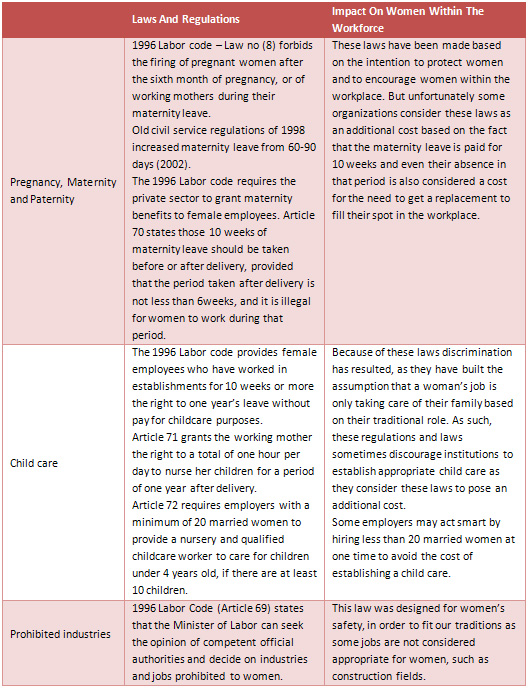
Source: Our elaboration.
Economic factors
Women represent half of any given
society. Sadly, a large percentage
of them are not contributing to the
workforce. To ensure the development
of any given society, men and women
need to be productive and active to
be part of the advancement in our
society (Olaimat & Al-Louzi, 2010).
Women in Jordan are still affected
by many factors that hinder their
economic participation, like legal
issues, the availability of childcare
services, poverty, and the high costs
of living. In addition, the role of
women in our society and traditional
views about women employees lead to
low self-esteem and lack of confidence
to contribute in the workforce (Olaimat
& Al-Louzi, 2010).
Jordan is considered among the countries
with a high cost of living in comparison
to other countries, such as Saudi
Arabia and Vietnam (Al Qadi &
Gharib, 2012).
Consequently, women with a high-income
tend to have the ability to cover
the costs of childcare or a nanny,
and as such, they tend to participate
more in their careers (Moghadam, 2013).
However, women with middle income
may perceive that the income they
earn would be spent on a nanny, childcare
and transportation, which means that
their expenses would exceed their
earnings. So in some cases, they would
rather stay home than work.
Unfortunately, women with low income
can't afford having a nanny, childcare
and transportation to help in taking
care of the house while they're at
work, and therefore, they tend to
participate less (Al-Qadi & Gharib,
2012).
Some researchers note that the low
participation rate of women in Jordan
is considered to be a cost on Jordan's
economy. This is especially the case
when a large percentage of these women
are highly educated, which means that
there is a serious waste of human
resources (Peebles et al., 2007).
Investing in women's education and
employment will lead to building a
more efficient human resource base
(Moghadam, 2013).
The Ministry of Labor noted that women
are not aware and familiar with their
labor rights. Therefore, women need
to be more informed about their laws
and regulations. Moreover; the ability
and strength to enforce the labor
laws and regulations is needed by
the government (Peebles et al., 2007).
Social factors
Jordan is a country that has a distinct
culture, which is considered to be
a nice blend of old and new. However,
the traditions in Jordan have a major
effect on how people live, think and
act. Many foundations have been founded
and supported by the royal family,
to protect women, empower them and
fight for their rights, for the intention
of building opportunities for a high
quality of life.
A recent study on women in tourism
noted that "25.3% of women working
in the tourism sector were harassed
by colleagues and customers, since
it is not commonly accepted that women
work in this field in Jordan"
(Majcher-teleon & Slimène,
2009).
Women are also perceived to be less
capable of handling job difficulties,
so they are usually discouraged to
join some fields like the technical
fields. This is especially the case
when some work aspects require field
work and late working hours like with
construction engineers, which is considered
more appropriate for men, with only
0.5% of women in this field (Ojakaa,
Olango, & Jarvis, 2014)
Some Jordanian organizations care
about and judge based on the physical
appearance, so that they tend to hire
women who are dressed more fashionable,
and are stylish and elegant, especially
in the private sectors. Some people
are of the opinion that women will
get more chances because they are
"more beautiful". However,
wearing Hijab is a requirement for
certain organizations due to the type
of customers that they serve. But
studies have shown that in the private
sectors women wearing the Hijab have
problems getting hired. But it is
still not clear if this is due to
appearance or religious reasons (Peebles
et al., 2007).
Getting married is one of the main
priorities for men and women in Jordan.
Women sometimes work until they find
the right husband, and after that,
they start to not taking their job
seriously or quit their jobs (Sawalha,
1999).
Technological Factors
Information technology has spread
widely all over the world. Different
life sectors such as education, health,
government, and customer services
are following the latest technology
trends, in order to enhance the quality
of service, maximize customer satisfaction,
and reduce managerial costs.
Telecommunication has made it easier
for women who have kids to check up
on them during the day, and she can
even use web cams to keep her eye
on her kids during working hours.
On the other hand, these technological
improvements introduce some pressures,
especially for employees. Nowadays,
employees are required to be notified
and responsive to their work notifications,
even after working hours and on weekends.
Now organizations consider this to
be their right and employees are obliged
to be responsive as long as they have
a Smartphone (Hanson, 2007).
Methodology
Our research is typically concerned
with women employees, who are considered
essential to our society. There has
been a trend of women leaving the
workforce. Researchers have heavily
investigated in separate studies the
different factors that influence women
within the workforce and lead to discriminatory
practices in and out of their working
environment.
An IE framework (internal and external
factors) will be conducted to categorize
the several factors that are considered
to be the main reasons behind women
leaving the workforce and not contributing
to society.
The internal factors are within the
working environment, and will be categorized
as: gender stereotype, gender inequality,
unequal opportunities, and income
gap. These factors are all within
the control of the organization, and
may affect women's decisions about
working, whether to proceed or drop
out, and not to contribute to society.
The external factors are the factors
that are beyond the control of the
organization, and may also affect
women's decisions and intentions about
proceeding with their careers. The
PEST analysis model will be conducted
to analyze the external factors that
may affect women employees.
Therefore, this study will be qualitative
in nature rather than quantitative
as it will give women employees the
ability to express their own thoughts
and beliefs that they face inside
and outside their working environment.
Accordingly, we can determine the
factors that are mostly affecting
women employees and clarify their
thoughts and attitudes toward their
careers.
The interviewed group includes five
women from different organizations,
career paths and marital statuses.
The organization environment can influence
women employees, it needs to be healthy
and understanding of the women's role
in our society, plus their career
paths are taken into consideration,
because some careers are considered
more appropriate for women and vice
versa, in addition to their marital
status as single women may think differently
than married women and even in prioritizing
their jobs. This is going to be demonstrated
later in this chapter.
Confidentiality is assured, as the
records are only going to be heard
and analyzed by the researcher group
of this study, and neither the interviewers'
names or the name of the organizations
they work for are going to be mentioned
in the data analysis chapter.
We have extended our research to include
an interview with the Jordanian Women
Union which is an institution that
supports women in Jordan, and offers
opportunities to encourage them to
work under the right circumstances.
They also fight for women's rights
and increase awareness among Jordanian
women about their legal rights.
As the general manager of the JWU
noted, there are two main factors
that actually affect women's participation
in the workforce: first are the social
and the cultural values and beliefs,
the second are the political factors.
This institution has conducted many
studies on female participation within
the workforce and the level of participation
in Jordan.
The general manager noted, "Women
present 52% of our society. Accordingly,
almost half of our society is inoperative
in the production process, and surprisingly
that by the increasing level of women
education and the rate of turnout
on education still women represent
only 14% in the Jordanian workforce.
Why is this happening?"
In addition, the union believes that
if the right requirements within the
workforce environment were available
for women, like childcares, equal
opportunities and decent wages, women
would be encouraged to participate
in the workforce.
The general manager of the JWU also
noted that "marriage sets some
responsibilities on women, so that
all the work distribution will be
against women. For example, women
are responsible for their house chores,
plus, for the birth of child, in addition
to after birth conditions. Accordingly,
the mentality and the way men think
as if they helped with the house chores
they consider themselves like doing
some extra work."
Therefore, we will take into consideration
their marital status because women
employees tend to think differently
according to their marital status,
and even discriminatory practices
and social perceptions differ from
single to married women (Moghadam,
2013).
To summarize, this research will be
qualitative in nature to gain a deep
understanding of women's behaviors
and beliefs, as we will conduct open
interview using open-ended questions,
with women from different institutions
and career paths, or even those who
have already left the workforce.
Data Analysis
Data analysis is considered one of
the most important practices, which
is adopted to study and evaluate collected
data into useful information. Such
practice will lead to better decision-making
and building hypotheses.
This section presents data that was
collected during our interviews with
a sample of five people. As mentioned
earlier in the previous chapters,
this study will be qualitative in
nature.
On another level, we will be testing
the IE framework hypothesis to check
if it matches the problems that women
actually face in their career paths,
whether in or out of their working
environment.
According to the IE framework, women
in the workforce face many discriminatory
practices internally and externally.
These factors may have a major influence
on the level of contribution.
Table 2: Description of the interviewed
personnel

Source: Our elaboration.
According to the table above each
of these interviews will be categorized
based on the IE framework and beneath
each table the data will be analyzed
and discussed.
Table 3: Woman 1 IE Framework
Analysis
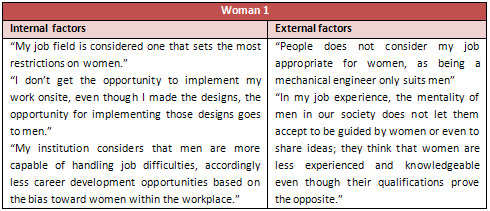
Source: Our elaboration.
According to woman number 1, her
career development was hindered based
on gender inequality and gender stereotypes,
which lead to the unequal attainment
of the opportunities offered.
But still she believes that the working
environment can't suit everybody.
As she noted, "you can't request
a working environment that suits every
working individual."
She also noted that, "there can
be many reasons for me to change my
career path, as if I got married I
will seek another career such as teaching,
but for now I am not considering leaving
the workforce."
Table 4: Woman 2 IE Framework
Analysis
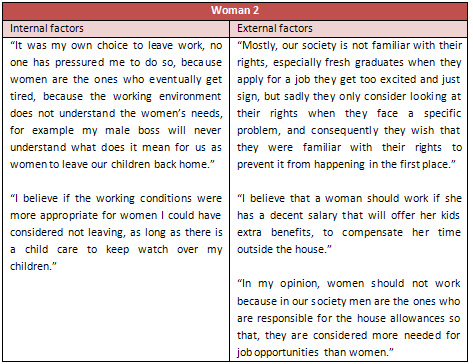
Source: Our elaboration.
In this case, woman number two has
a very traditional way of thinking.
Accordingly, the social, cultural
traditions and beliefs have a major
effect on the way she perceives work.
She noted that "women can't manage
between their home and jobs so if
the family is stable financially,
women should stay at home taking care
of their kids."
Regardless of her traditional way
of thinking, still it was obvious
that her experience within the workforce
was not that pleasant. Also, the lack
of understanding of women's needs
is setting some obstacles that discourage
women from participating.
Table 5: Woman 3 IE Framework
Analysis

Source: Our elaboration.
Woman 3 is a perfect example for
such a case, as she can be considered
to be a victim of discriminatory practices
within the workplace. Some of the
employers from the same organization
noted that, "she has been in
the same management level for 5 years
in consequence every raising opportunity
that she was supposed get, where given
to men based on gender bias."
They also noted that, "she is
very smart and hard working women
and definitely more appropriate for
advancement in her career."
This woman is considering leaving
her work due to her terrible working
environment that does not understand
women's needs. The lack of understanding
of women's roles in our society is
discouraging women from proceeding
with their careers, along with the
discriminatory practices that are
delaying their development.
Unfortunately, this has led to frustration
even with other female employees in
the same organization, as they have
also noted, "women in this organization
go through many difficulties and delays
within their development, as here
men always get the priority for raises."
Despite the consequences of the external
factors, organizations need to be
more concerned about their employer's
productivity, and motivate them by
offering the right working conditions.
This woman has made it clear that
organizations can make her life much
easier if they gave her the opportunity
to leave work earlier and finish her
tasks at home. Accordingly, the technological
factors can be used in a more effective
way by the organization to ease the
jobs of working mothers.
Table 6: Woman 4 IE Framework Analysis

Source: Our elaboration.
This woman has left the workforce
mainly for external reasons, as she
felt that the salary she got wasn't
worth her time out of the house, and
the fact that she couldn't leave her
kids in the time when they need their
mother most.
Accordingly, women feel that they
are the only ones responsible for
their kids and house care, and that
view comes from the gender stereotype
and our traditional view of women.
But still, internal factors can influence
the level of participation, as the
lack of motivating factors within
the working environment; in addition
to the unequal treatment have made
women less attached to their job and
career development.
Table 7: Woman 5 IE Framework
Analysis
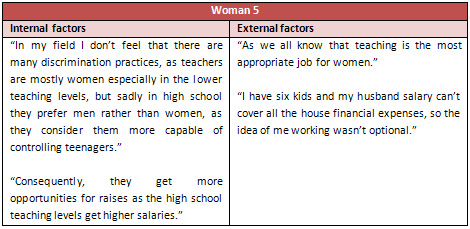
Source: Our elaboration.
According to this case, unfortunately
women work only for financial security,
as we didn't feel that they were seeking
it for personal or career development.
Even in fields that are considered
most appropriate, women still face
discriminatory practices. The female
gender role is perceived negatively
based on the fact that it is thought
that women are weaker and less capable
of handling job difficulties.
According to the data analysis, many
findings were determined that have
supported our hypothesis, and they
will be explained and discussed in
the next chapter.
Discussion
In this chapter we will discuss our
findings related to our hypothesis.
As we mentioned earlier, the aim of
this study is to ascertain the reasons
behind women leaving the workforce
and not contributing to society.
Therefore, we have developed a conceptual
framework that we thought would be
helpful in such a case. Many factors
were suggested and many results have
been found, and now we will discuss
and prove how these results support
our hypothesis according to our analysis
technique. The figure below supports
our hypothesis as follows:
Figure 1: The IE framework according
to women employees
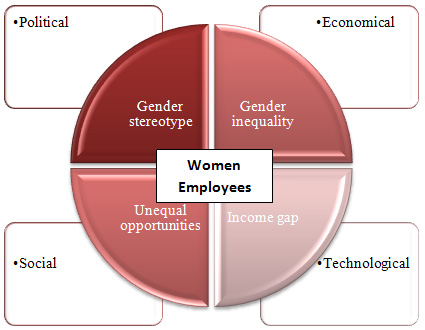
Source: Our elaboration.
Figure 1 depicts the IE framework,
and it shows that women employees
are the center of this research. Women
employees are affected by several
factors that might lower their level
of participation.
The Internal Factors Analysis
Figure 2: Internal factors affecting
women employees within their working
environment.
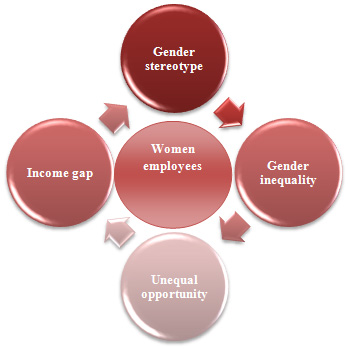
Source: Our elaboration.
Women's participation levels are
affected by these factors, because
such discriminatory behaviors lead
to frustration and disappointment
within the working environment. Consequently,
women will tend to feel less attached
to their jobs and the plans to leave
the workforce are based on external
reasons that we are going to explain
later in this chapter.
The External Factors Analysis
The figures below show some comments
about women. We have analyzed them
in accordance to the external factors.
Interview Analysis for the Political
Factor
Figure 3: Political factor interviews
analysis
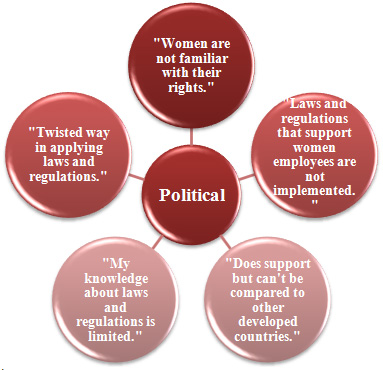
Source: Our elaboration.
According to our analysis, laws and
regulations have been developed to
favor women as they intend to protect
female employees within their working
environment.
Besides, we have found out that there
is a lack of knowledge among women
employees about their laws and rights,
which make these laws and rights seem
unnecessary to implement.
Disappointedly, discriminatory practices
take place even with these laws and
regulations. Affected women employees
become less motivated to proceed or
participate in the workforce on account
of the lack of support.
Interview Analysis of Economic
Factors
Figure 4: Economic factors Interviews
analysis
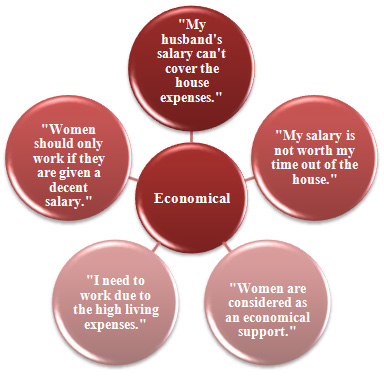
Source: Our elaboration.
In line with the participants' responses,
economic factors have an influence
on how women employees perceive work,
as they consider their jobs as a way
to secure their families.
Interview Analysis Social Factors
Figure 5: Social Factors Interview
Analysis
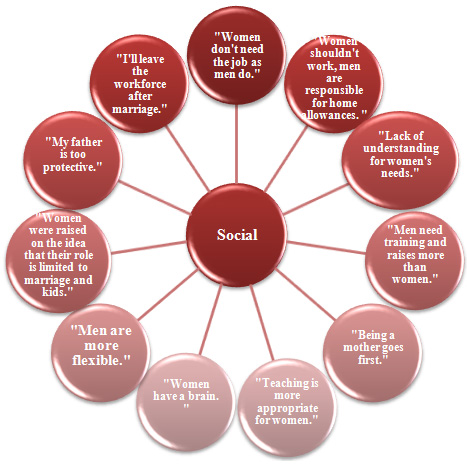
Source: Our elaboration.
According to the figure above, the
social factors are the factors that
have the largest amount of comments,
which means that women employees are
mostly getting affected by social
and cultural values and traditions.
Women in our society consider themselves
as a mother first, then as an employee,
therefore their job as a mother is
primary. If a woman felt in any way
or another that her job is affecting
and harming her motherhood, she will
have a tendency to leave the workforce
(Peebles et al., 2007).
Social factors are not only affecting
women roles; they are even affecting
women's choices and preferences. Moreover,
women tend to participate in fields
that the society finds more appropriate
for women, and if the society perceived
the opposite, women will feel less
comfortable, and will reconsider to
change their careers paths (Hattab,
2012).
Interview Analysis of Technological
Factors
Women employees and organizations
are not taking into consideration
technological factors. But in the
technical fields they have very late
working hours and sadly they tend
to leave women working overtime even
though they can complete their tasks
at home. We think that further research
needs to be done on technological
factors and how they can be used more
effectively for employees within the
organization (Mamaghani, 2006).
The Balance between Women Primary
and Secondary Job
Figure 6: Balance between women's
primary and secondary job
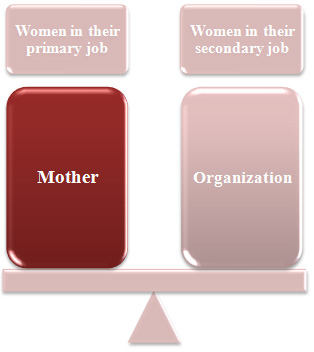
Source: Our elaboration.
This figure shows that women tend
to participate as long as there is
a balance between home and work, regardless
of the fact that their role as a mother
is their primary job.
Accordingly, as long as the balance
has been made, women will benefit
from their job, because that will
increase the level of security in
their families.
The Imbalance Between Women's
Primary And Secondary Jobs
Figure 7: Imbalance between women's
primary and secondary jobs
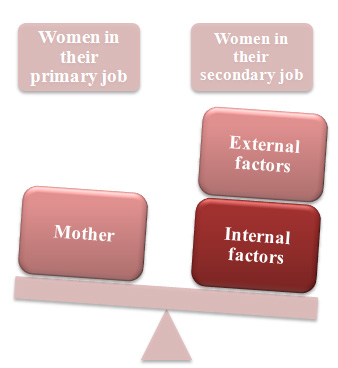
Source: Our elaboration.
Accordingly an imbalance between
home and work can occur due to an
unhealthy working environment that
stresses women, leading to frustration
and disappointment. This can make
them less capable of managing their
house and they tend to leave the workforce.
Women need to be understood and motivated
under the right conditions within
the workplace. They need to be encouraged
to proceed within an organization's
working environment that is equal,
motivating and understanding toward
a woman's role. This will have positive
outcomes for women's participation
in the workforce.
Limitations and Recommendations
Most studies we found were conducted
on women who live in a culture which
is totally different from our Jordanian
culture. When we started to write
down our hypothesis, we raised all
possible factors internally or externally
which can be considered to affect
women's participation in the workforce.
Nevertheless, due to the tight deadline,
we believe that it would be recommended
if we studied each factor in depth,
in order to have stronger evidence
to our hypothesis.
On another level, this study was qualitative
in nature. The group sample needed
to involve women from different sectors,
but in our research we couldn't get
the chance to meet and involve women
employees from the public sectors.
This was despite the fact that the
participants noted that it's necessary,
as women in the public sectors perceive
work differently.
Our studying and researching in this
topic won't stop here and we would
love to take it a step further. Accordingly,
for future work we recommend the following:
• Women from different backgrounds
and sectors will be interviewed, in
order to gain the proper amount of
information needed to build a comprehensive
research.
• Further research shall be conducted
on women's biological differences.
As the biological characteristics
determine how women feel, act and
think, they can consequently have
an influence on how women perceive
work and set their priorities (Williams,
1988)
Conclusion
Women are considered half of any
given society, and as such, empowering
women is a tool to ensure development
in our Jordanian economy, because
we cannot succeed if half of us are
held back. Accordingly, this research
aims to investigate the reasons behind
women leaving the workforce.
After going through many previous
studies, we discovered some factors
that have affected women employees
inside or outside of their working
environment.
The methodology was qualitative in
nature by which we conducted an open
interview using open-ended questions
with a group of people from different
organizations, career paths and marital
status, to analyze their responses
in accordance to our hypothesis.
The IE framework has proved its efficiency,
as the results have supported our
hypothesis.
We found that the internal factors
are all connected to each other, and
in some cases, one may lead to another.
In addition, women employees do not
leave the workforce based on internal
reasons, but sadly, when they become
less motivated, productive and attached
to their jobs. The external factors
exert the main influences on women's
participation in the workforce. In
Jordan, people value their culture
and traditional views, and therefore,
this has had an influence on how people
think and perceive women in our society.
Women now are associated with their
traditional role as a mother and they
perceive it as their primary job,
and being a female employee is considered
to be their secondary job (Majcher-teleon
& Slimène, 2009).
Accordingly, women need to maintain
a balance between their primary and
secondary job to proceed with their
career path. If there is an imbalance,
women tend to leave the workforce,
because it harms their level of effectiveness
in their primary job, and being a
mother always goes first in our society.
References
Al-Badayneh, D. M. (2012). Violence
against women in Jordan. Journal of
Family Violence, 1-11. doi:10.1007/s10896-012-9429-1.
Al-Qadi, N. & Gharib, A. A. (2012).
The economic and Social Changes by
People with Special Needs Arising
from Poverty in the South Region of
the Hashemite Kingdom of Jordan, Canadian
Social Science, 8(4), 28-37. Doi:10.3968/j.css.1923669720120804.
Aycan, Z. (2004). Key success factors
for women in management in Turkey.
Applied Psychology, 53(3), 453-477.
Broverman, I., Vogel, S., Broverman,
D., Clarkson, F. & Rosenkrantz,
P. (1972), Sex-Roles: a current appraisal,
Jornal of Social Issues, 28, 181-93.
Choi, J. & Mogyoro, M. (2011).
Influence of Internal and External
Factorson Expansion Strategy:-Swedish
Cleantech Subsidiaries in the US.
Crowley, T. & Rolfe, H. (2008),
Work-related learning for an innovation
nation: Engaging with employers to
improve work-related learning opportunities
for young people aged 14-19, National
Endowment for Science, Technology
and Arts(work commissioned by NESTA),
United Kingdom.
Council, N. (2008). Status of Violence
against Women in Jordan.
Doepke, M., Tertilt, M., and Voena,
A. (2011), The economics and politics
of women's rights, National Bureau
of Economic Research, Working Paper
17672, forthcoming.
Ford, R., Goodwin, M. J., & Cutts,
D. (2012). Strategic Eurosceptics
and polite xenophobes: Support for
the United Kingdom Independence Party
(UKIP) in the 2009 European Parliament
elections. European Journal of Political
Research, 51(2), 204-234. doi:10.1111/j.1475-6765.2011.01994.x.
Hanson, J. (2007). 24/7: How Cell
Phones and the Internet Change the
Way We Live, Work, and Play. Greenwood
Publishing Group. Retrieved from https://books.google.com/books?hl=en&lr=&id=rrA23DxjRwwC&pgis=1.
Hattab, H. (2012). Towards understanding
female entrepreneurship in Middle
Eastern and North African countries:
A cross-country comparison of female
entrepreneurship. Education, Business
and Society: Contemporary Middle Eastern
Issues, 5, 171-186. doi:10.1108/17537981211265561.
Heilman, M.E. (1997), Sex discrimination
and the affirmative action remedy:
the role of sex stereotypes, Journal
of Business Ethics, 16, 877-89.
Heilman, M. E., & Eagly, A. H.
(2008). Gender stereotypes are alive,
well, and busy producing workplace
discrimination. Industrial and Organizational
Psychology: Perspectives on Science
and Practice, 1(4), 393-398. doi:10.1111/j.1754-9434.2008.00072.x.
Jamali, D., Sidani, Y. & Safieddine,
A. (2005). Constraints facing working
women in Lebanon: an insider view.
Women in Management Review, 20 (8),
581-94.
Jordan - Human Resources - Human Rights.
(n.d.). Retrieved April 6, 2015, from
http://www.kinghussein.gov.jo/resources5.html.
Kausar, Z. (1995). Women in Feminism
and Politics: New Directions towards
Islamization (in Omar and Davidson,
2001).
Keyssar, A. (2009). The Right to Vote:
The Contested History of Democracy
in the United States. Basic Books.
Retrieved from https://books.google.com/books?hl=en&lr=&id=UijIgQP0xF8C&pgis=1
Kharouf, A. Al, & Weir, D. (2008).
Women and work in a Jordanian context:
beyond neo-patriarchy. Critical Perspectives
on International Business, 4(2/3),
307-319. doi:10.1108/17422040810870060
Khattab, H. (1996). The Muslim Woman's
Handbook, TA-HA, London.
Majcher-teleon, P. A., & Slimène,
O. B. (2009). Women and Work in Jordan
Case Study of Tourism and Ict Sectors.
Security, (July).
Mamaghani, F. (2006). Impact of information
technology on the workforce of the
future: An analysis. International
Journal of Management, 23 (4), 845.
Meeting of the OECD Council. Gender
equality in education , employment
and entrepreneurship?: final report
to the MCM 2012 Gender Equality in
Education , Employment and Entrepreneurship?:
Final Report to the MCM 2012 C / MIN
( 2012 ) 5. In OECD Pub, pp. 23-24.
Metle, M. (2002). The influence of
traditional culture on attitudes towards
work among kuwait women employees
in the public sector, Women in Management
Review, 17, 245-61.
Moghadam, V. (2013). Women , work
and family in the Arab region?: Toward
economic citizenship, June, 2-3.
Mogyoro, M. (2011). Influence of Internal
and External Factors on Expansion
Strategy -Swedish Cleantech Subsidiaries
in the US.
Mostafa, M. M. (2003). Attitudes towards
women who work in Egypt. Women in
Management Review, 18(5), 252-266.
Ojakaa, D., Olango, S. & Jarvis,
J. (2014). Factors affecting motivation
and retention of primary health care
workers in three disparate regions
in Kenya. Human Resources for Health,
12(1), 33. doi:10.1186/1478-4491-12-33.
Olaimat, H., & Al-Louzi, S. (2010).
Empowering Rural Women through Income-Generating
Projects: A Case Study in Jordan.
Jordan Journal of Social Sciences,
1(1).
Peebles, D., Darwazeh, N., Ghosheh,
H. & Sabbagh, A. (2007). Factors
affecting women's participation in
the private sector in Jordan. National
Center for …. Retrieved from
http://www.bpwa-amman.org/Library/633868660527307500.pdf
Pegu, A. (2015). Female Workforce
Participation in North-Eastern Region?:
An Overview, 6959(154), 154-160.
Sawalha, L. (1999). Barriers of Silence:
Reproductive rights for women in Jordan.
Development, 42(199903), 41-46. doi:10.1057/palgrave.development.1110009
Schreiber, P. (1998). Women's career
development patterns, New Directions
for Adults and Continuing Education,
80, 5-13.
Stockemer, D., & Byrne, M. (2011).
Women's representation around the
world: the importance of women's participation
in the workforce. Parliamentary Affairs.
Tlaiss, H., & Kauser, S. (2010).
Perceived organizational barriers
to women's career advancement in Lebanon.
Gender in Management: An International
Journal, 25(6), 462-496. doi:10.1108/17542411011069882
Tlaiss, H., & Kauser, S. (2011).
The impact of gender, family, and
work on the career advancement of
Lebanese women managers. Gender in
Management: An International Journal,
26(1), 8-36. doi:10.1108/17542411111109291
Tlaiss, H., & Kauser, S. (2011).
Career success of Arab women managers:
an empirical study in Lebanon. Education,
Business and Society: Contemporary
Middle Eastern Issues, 4(1), 43-61.
U.S. Dept of Labor. (2009). An analysis
of reasons for the disparity in wages
between men and women: A report by
CONSAD Research Corp. Development.
Weir, D.T. (2003), Human resource
development in the Arab middle east:
a fourth paradigm, in Lee, M. (Ed.),
HRD in a Complex World, Routledge,
London, 69-82.
Williams, J.E. and Best, D.L. (1990),
Sex and psyche: gender and self viewed
cross-culturally, Sage, Newbury Park,
CA.
|